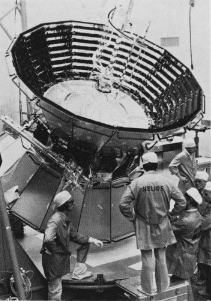
Helios 2 was launched into a solar orbit on 15 January 1976. It had a
perihelion of 0.29 AU and an aphelion of 1 AU. Its orbit made it an ideal
platform for making long baseline time-of-arrival measurements to obtain
source direction. The satellite rotated with a ~ 1-s spin period. The mission
ended in 1981.
The first instrument capable of exploring linear time profiles of gamma-ray
bursts was on the Helios 2 satellite. It consisted of a 1.5 inch diameter x
0.75 inch thick CsI(Tl) scintillator. The data were stored in 3 independent
memories, with integrations of 250 ms, 32 ms, and 4 ms. Half of each memory
circulated real-time data, while the other halves stored data only if a
trigger occurred. Thus, precursor information was kept. Nested time
histories for 128 s with 250 ms resolution, 16 s with 32 ms resolution, and
2 s with 4 ms resolution were recorded. A trigger could occur by the count
rate exceeding any of 3 time-based rate comparisons with thresholds
commandable from the ground. The lower energy threshold could be adjusted
from 60 to 110 keV in 8 steps, while the upper threshold was 1500 keV. The
instrument
operated nearly continuously, shutting down only for solar occultation and an
occasional incidental power shutoff.
Gamma-ray bursts detected by Helios 2 suggested some similarities in the
fine time resolution structures of different bursts. The Helios 2 data,
when added to the information provided by its contemporaries ISEE 3, Venera
11, Venera 12 and others, provided new tools to scientists trying to
discover the nature and origin of gamma-ray bursts.